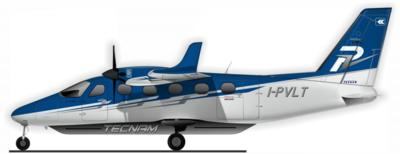Owners Get Priority Slots for P-Volt Upgrade
Tecnam Aircraft is easing its owner base into the sustainable, green future with a program to transition extant P2012 Traveller piston aircraft into the P-Volt, the same plane equipped with a Rolls-Royce electric propulsion system for the advance air mobility market. Current owners can get first dibs on conversion slots to update their older aircraft to the new equipment should they want to future-proof their plane.

The P-Volt is build on Tecnam's P2012 Traveller, hosting the same suite of avionics and many parts, with similar flight dynamics and training requirements. The key difference lies in the typical cruise speed and range, owed to the P-Volt's inclusion of battery-powered electric motors in place of piston engines. Its easily, quickly swapped battery packs allow owners to upgrade to newer technology as it comes to market, or enjoy a much more affordable path to refresh batteries in a low state of health. Unlike built-in battery systems that can require a costly, time-consuming refurbishment to replace, the P-Volt will allow for consistent performance throughout the aircraft's service life.
Once converted to P-Volt spec, customers will enjoy cheaper, more sustainable operation and lower costs compared to their P2012, but with some caveats. With projected numbers from Tecnam computed with the battery at a 90% state of health, the conversion may not seem ideal for some use cases. With today's range of 85 nm, and a 2030 projection of 145 nm, the P-Volt could relegate itself to local airport lifts and training scenarios as its range is absolutely outclassed by the P2012's 950 nm. Similar trade-offs occur in carrying capacity, with the full fuel payload dropping by about 150 pounds, and diminished overall useful load figures. With piston engines, payload can be exchanged with fuel when necessary, but battery power density is not yet strong enough to allow such trades. Another drawback of the P-Volt is the drop in maximum speeds, estimated as 14 knots slower at FL 050 than it's predecessor's 194 knots at FL100. Aviators are no strangers to compromise, however, so those with a suitable
philosophy of use may find the conversion well worth the trouble.

Those shortcomings may not remain for long, if the battery industry can create suitable products. Matheu Parr, Customer Director with Rolls-Royce Electrical said that development is one of their primary goals. "Our energy storage systems (ESS) will enable P-Volt to undertake zero emissions flights of 100nm this decade and improve from this position as battery technology develops.”
Fabio Russo, Tecnam's Chief R&D officer, has similar sentiments. "The battery industry is actively working on developing higher energy storage capability solutions and technology may advance faster, however, Tecnam and Rolls-Royce are focusing on solutions that are real, commercially viable and that can only improve with time,” he said.
Russo said the company sees a healthy future through building real solutions with a stable transition to green aviation. “Green innovation is paramount and real innovation takes time, we see many businesses overpromising. This is not how we do things at Tecnam. The Transition Program is a real path where we have the? P2012 Traveller, already in service, that will make the transition to the P-Volt as smoothly as possible, especially for those operators accustomed to flying with 20+ seat aircraft."
 ANN's Daily Aero-Term (05.09.24): Hold Procedure
ANN's Daily Aero-Term (05.09.24): Hold Procedure ANN's Daily Aero-Term (05.06.24): Altitude Readout
ANN's Daily Aero-Term (05.06.24): Altitude Readout ANN's Daily Aero-Linx (05.06.24)
ANN's Daily Aero-Linx (05.06.24) Airborne-NextGen 05.07.24: AI-Piloted F-16, AgEagle, 1st 2 WorldView Sats
Airborne-NextGen 05.07.24: AI-Piloted F-16, AgEagle, 1st 2 WorldView Sats Aero-News: Quote of the Day (05.07.24)
Aero-News: Quote of the Day (05.07.24)




